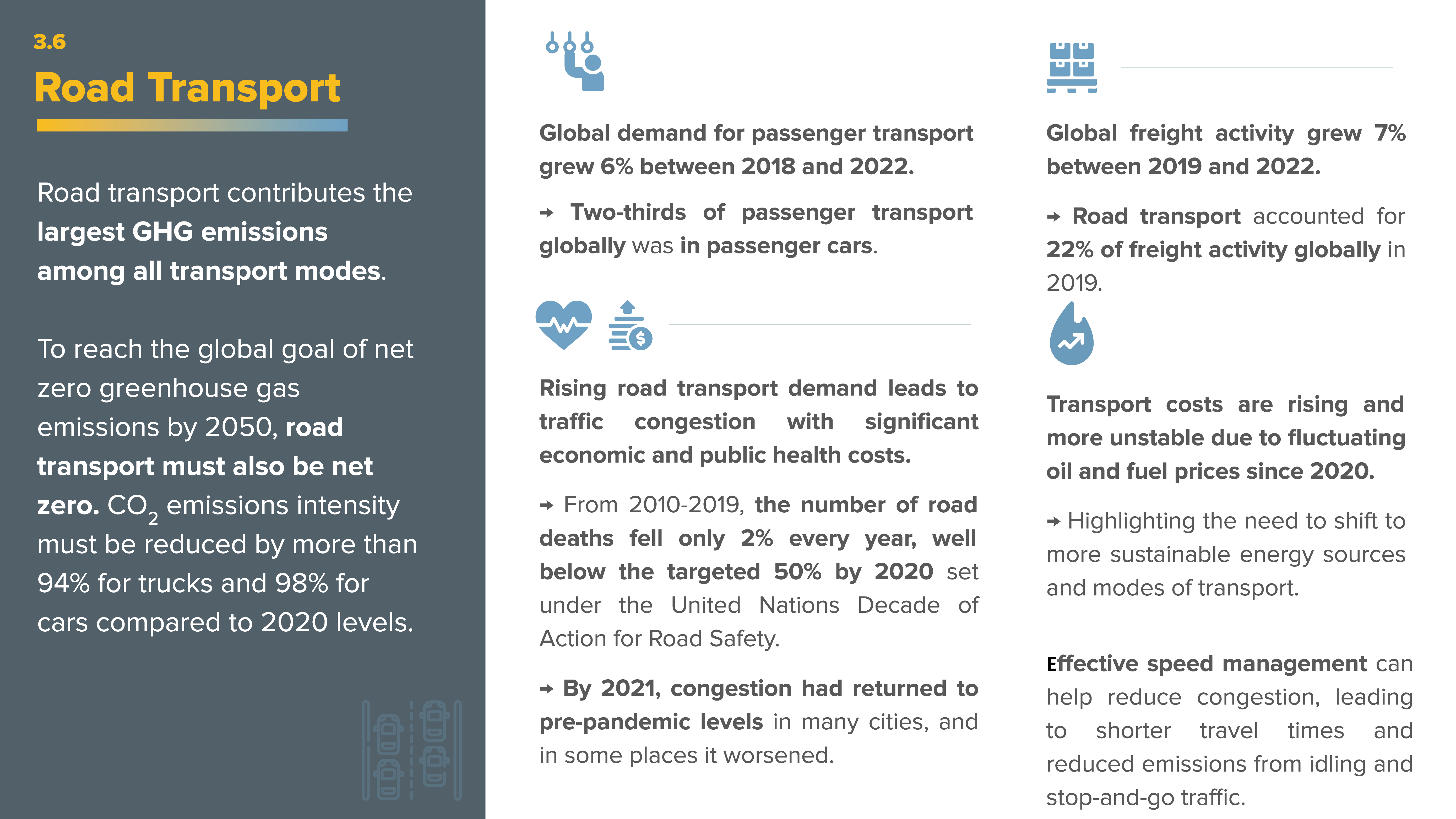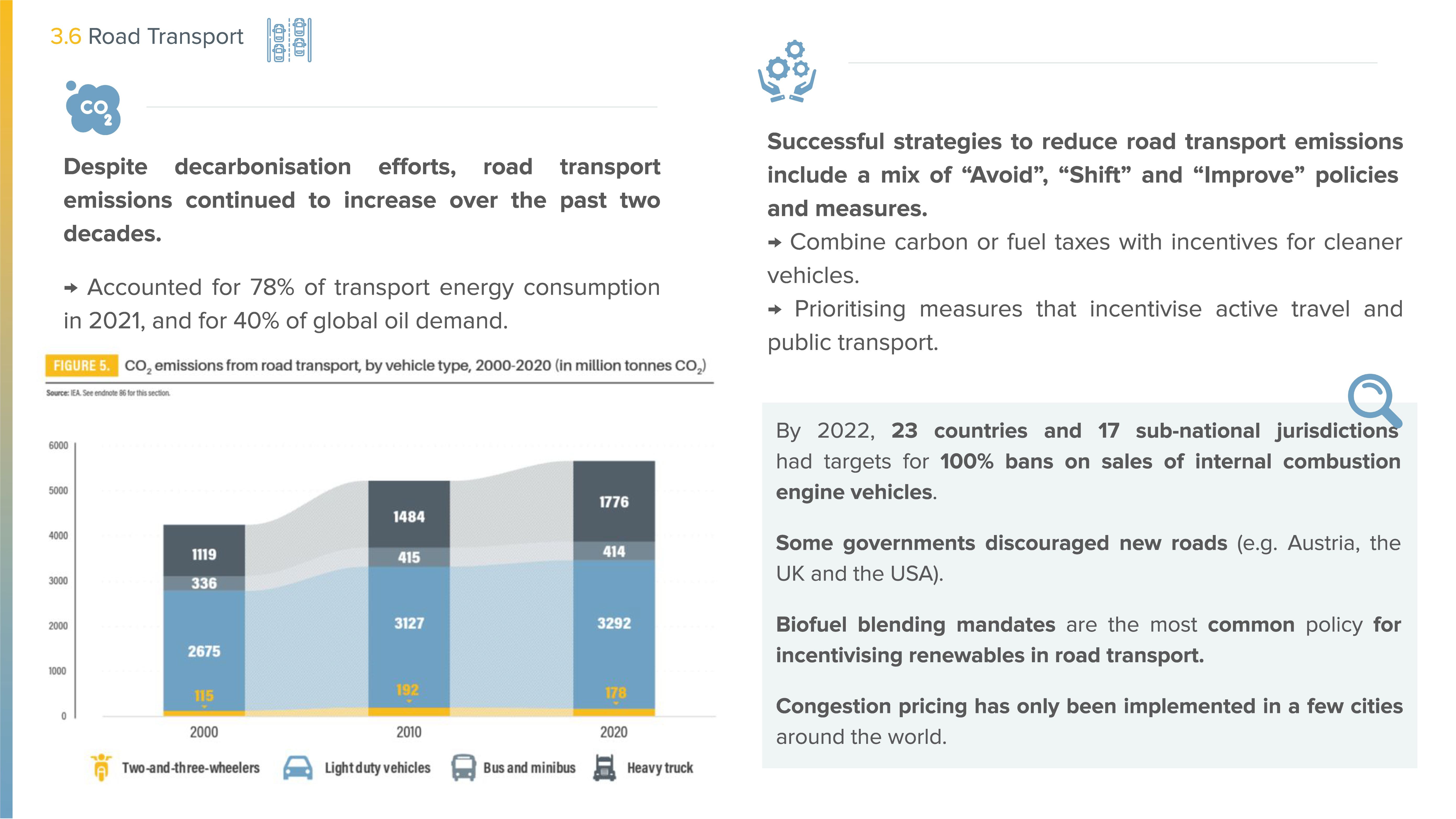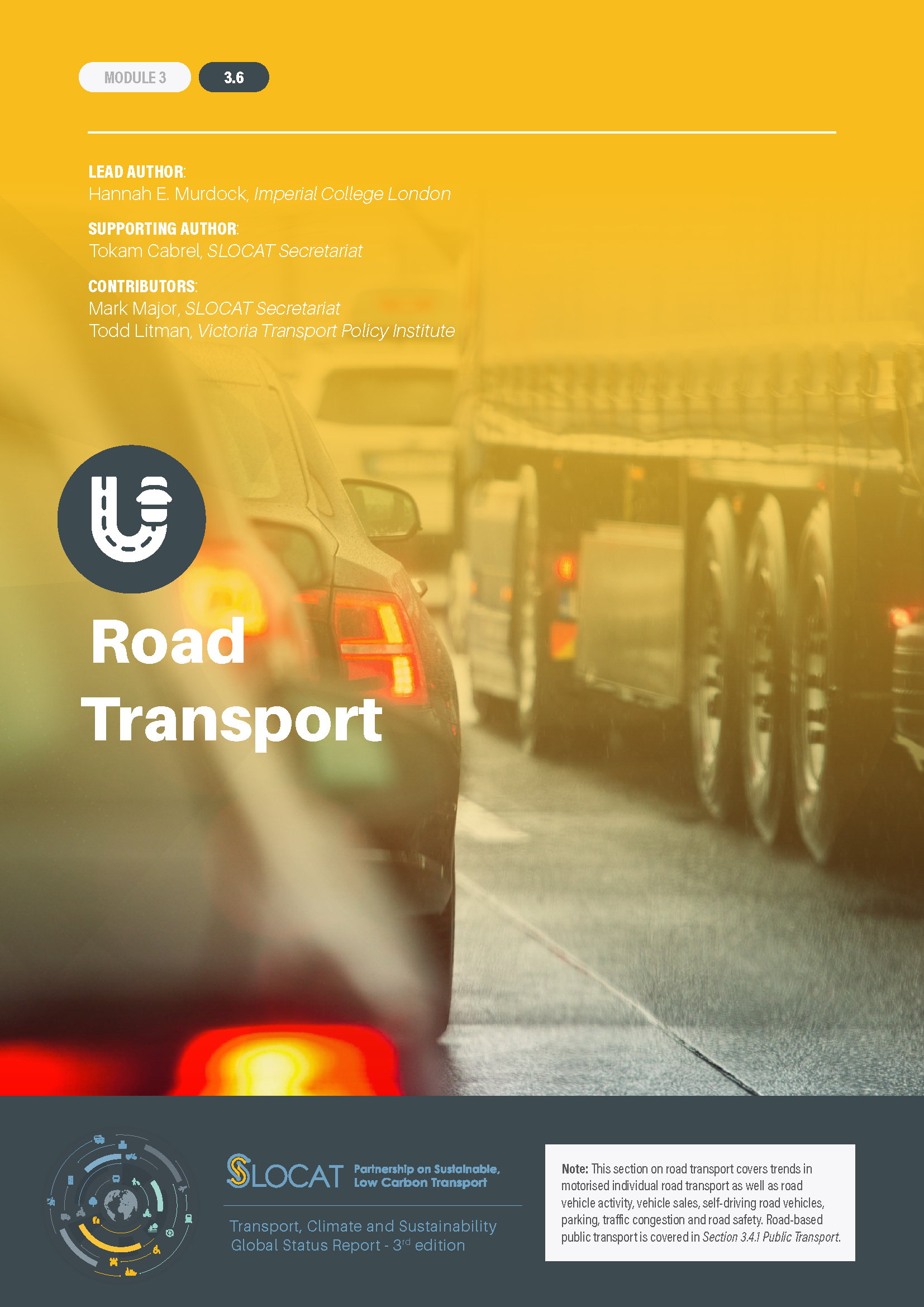-
Road Transport
- Key Findings
- Road transport contributes the largest greenhouse gas emissions among all transport modes.
- Some governments have taken strong action to encourage the shift towards sustainable modes of transport as well as to reduce vehicle travel, promote low-emission vehicles, improve fuel efficiency and increase the use of renewable fuels.
Demand trends
- Global demand for passenger transport (of all forms) grew 6% between 2018 and 2022, reaching 26.4 trillion kilometres. Nearly two-thirds of passenger transport globally was in passenger cars, although the modal split varies highly by location.
- Global freight activity increased an estimated 7% between 2019 and 2022, to surpass 179 trillion tonne-kilometres. In 2019, road transport accounted for 22% of freight activity globally, on average, although the modal split varies highly by location. Cargo bikes are increasingly being viewed as a more sustainable substitute for delivery vans.
- Since 2020, a rise in the global average price of oil has led to higher fuel prices, affecting overall transport costs. Because the transport sector relies on fossil fuels for 96% of its energy consumption, fluctuating oil prices can greatly impact the cost of operating motorised vehicles, highlighting the need to shift to more sustainable energy sources and modes of transport.
- Motorisation rates vary greatly by region, with the highest rate in North America – at four times the global average of 196 vehicles per 1,000 people – and the lowest rate in Africa, at a quarter of the global average, as of 2020.
- The number of cars per household varies greatly by income group and region; in the United Kingdom, for example, a quarter of higher-income households own three or more cars.
- Global automobile sales (for both passenger and commercial four-wheeled vehicles) dropped 13.7% in 2020, grew 5% in 2021 (to total 82.7 million units), then fell 1.4% in 2022 to 81.6 million units.
- Electric car sales grew 55% in 2022 to exceed a record 10 million units. More than 26 million electric cars were on the world’s roads that year, a five-fold increase from 2018.
-
Global shares of electric heavy-duty vehicles remain relatively low, with electric buses accounting for around 3.1% of the total bus stock, and heavy-duty trucks comprising just 0.4% of the total truck stock in 2022.
- The electrification of vehicles will not resolve several critical transport issues, such as traffic congestion, urban sprawl and the amount of public space devoted to vehicles. Studies have shown a correlation between higher prices for parking and greater use of public transport and active mobility, and in many places parking prices have increased sharply in recent years.
- Rising demand for road transport can lead to increased traffic congestion, with significant economic and public health costs. By 2021, congestion had returned to pre-pandemic levels in many cities, and in some places it worsened.
- High demand for private road transport can lead to declines in road safety, with a greater likelihood of road crashes. During 2010-2019, the number of road deaths fell only 2% annually on average, well below the targeted 50% by 2020 set under the United Nations Decade of Action for Road Safety.
Emission trends
- In 2021, fossil fuels supplied 96% of the total energy demand in transport – a share that has barely changed over the past decade even as biofuels and electric vehicles have increased – due mainly to rising overall demand.
- Road transport accounted for nearly 78% of transport energy consumption in 2021, and for 40% of oil demand globally.
- Road transport is the largest emitter of carbon dioxide (CO₂) among all transport modes, contributing 78% of transport emissions in 2020. Passenger transport accounted for more than two-thirds of the emissions from road transport, while road freight contributed the remaining nearly one-third. CO₂ emissions from road transport have continued to increase over the past two decades.
- Countries in Europe, North America and Oceania had the highest per capita road transport CO2 emissions in 2021. The United States contributed the highest road transport emissions in both absolute and per capita terms.
- As larger vehicle sizes have gained in popularity, their rising energy consumption is posing a growing risk to decarbonisation. Larger vehicles take up greater public and private space, consume far greater amounts of fuel than small- and medium-sized vehicles, and result in far greater emissions.
- It is important to evaluate vehicle impacts using life-cycle analysis, which accounts for resource consumption and emissions that occur not only during vehicle operation, but also during manufacturing and infrastructure production. Measured this way, hybrid and electric vehicles typically reduce emissions by one-third to two-thirds, depending on the fuel source.
- While safety on highways and urban roads can facilitate the use of multiple transport modes, road safety and climate change are interrelated and can impact each other in various ways. Effective speed management can help reduce congestion, leading to shorter travel times and reduced emissions from idling and stop-and-go traffic.
- Self-driving vehicles, automated vehicles and autonomous vehicles have the potential to decrease emissions if shared and regulated. However, there is also the risk of higher transport emissions by increasing the vehicle size and total vehicle travel, but these impacts are uncertain.
- To reach the global goal of net zero greenhouse gas emissions by 2050, road transport must also be net zero. CO2 emissions intensity must be reduced by more than 94% for trucks and 98% for cars compared to 2020 levels, according to the International Energy Agency’s Net Zero scenario.
Policy developments
- Successful strategies to reduce emissions from road transport include a mix of “Avoid”, “Shift” and “Improve” policies and measures. The most successful combine carbon or fuel taxes with incentives for cleaner vehicles, but prioritising measures that incentivise active travel and public transport can maximise emission reductions and co-benefits.
- By 2022, at least 23 countries and 17 sub-national jurisdictions had targets for 100% bans on sales of internal combustion engine vehicles, while several other jurisdictions had lower targeted shares.
- Some governments have discouraged new roads, such as Austria, the United Kingdom and the United States.
- Government financial support for electric vehicles nearly doubled in 2021, and support for electric two- and three-wheelers also advanced, including in many cities and in low- and middle-income countries. Governments also have enacted diverse policies and measures to support the deployment of electric vehicle charging infrastructure.
- Biofuel blending mandates continue to be the most common policy for incentivising renewable energy in road transport.
- Congestion pricing has been shown to reduce both emissions and fuel consumption and can lead to more liveable environments; however, this policy has only been implemented in a few cities around the world.
- A comprehensive and integrated approach to decarbonising freight transport could provide significant environmental and social benefits. In general, policies for decarbonising heavy-duty vehicles have tended to lag behind those for light-duty vehicles.
- Several policies at the regional, national and sub-national levels have been adopted in recent years to address road safety, particularly aimed at speed management and sometimes also specifically linked to improving the sustainability of transport systems.
Lead Author: Hannah E. Murdock, Imperial College London
Supporting Author: Tokam Cabrel, SLOCAT Secretariat
Contributors: Mark Major, Kühne Foundation; Todd Litma, Victoria Transport Policy Institute



